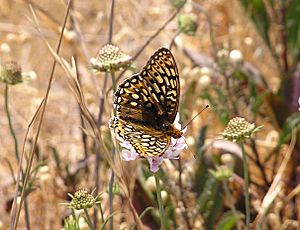Callippe silverspot butterfly facts for kids
Quick facts for kids Speyeria callippe callippe |
|
|---|---|
 |
|
| Conservation status | |
| Scientific classification |
|
| Kingdom: | Animalia |
| Phylum: | Arthropoda |
| Class: | Insecta |
| Order: | Lepidoptera |
| Family: | Nymphalidae |
| Genus: | Speyeria |
| Species: | |
| Subspecies: |
S. c. callippe
|
| Trinomial name | |
| Speyeria callippe callippe Boisduval, 1852
|
|
The Callippe silverspot butterfly (Speyeria callippe callippe) is a special type of butterfly. It belongs to the brush-footed butterfly family, called Nymphalidae. This butterfly is considered an endangered species by the government. This means it needs protection to survive.
Adult Callippe silverspot butterflies have a wingspan of just over two inches. Their wings are very pretty. They have a brown, tan, and black pattern on top. The undersides are orange-brown with shiny silver spots. Both their wings and body are a bit hairy. The young butterflies, called larvae or caterpillars, are dark and spiny.
| Top - 0-9 A B C D E F G H I J K L M N O P Q R S T U V W X Y Z |
What Does It Look Like?
The Callippe silverspot butterfly is easy to spot. Its wings are about two inches wide. The top of the wings has a cool pattern. It looks like brown, tan, and black scallops. These are like wavy edges.
Silver Spots and Hairy Bodies
The underside of the wings is even more unique. It is orange-brown with bright silver spots. These spots give the butterfly its "silverspot" name. The butterfly's wings and body are also covered in fine hairs.
Spiny Caterpillars
Before they become butterflies, they are caterpillars. These caterpillars are dark in color. They have many sharp, branching spines on their backs.
Where Does It Live?
The Callippe silverspot butterfly lives in a very specific area. It is found only in two grassland spots. These spots are in the San Francisco Bay Area in California. One area is near Oakland. The other is on San Bruno Mountain.
Losing Their Home
Sadly, the places where these butterflies live are shrinking. Many areas have been built up with homes and businesses. This development takes away the butterfly's natural habitat. This is why the butterfly is endangered.
Other Silverspot Butterflies
Other types of silverspot butterflies have been seen nearby. Some are found near South San Francisco. Others are in the hills above Pleasanton. They are also found at Sears Point and between Vallejo and Cordelia. Scientists are still studying if these are the same or different types of silverspot butterflies.
Life Cycle of the Butterfly
The Callippe silverspot butterfly has an interesting life cycle. It only has one generation each year. This means they complete their life cycle once a year.
What Caterpillars Eat
The caterpillars are very picky eaters. They only eat one type of plant. This plant is called the yellow pansy. It is also known as "Johnny Jump-up" (Viola pedunculata).
From Egg to Butterfly
Female butterflies lay their eggs on or near the yellow pansy plant. The tiny caterpillars hatch and spend the winter in a silk pouch. In the spring, they wake up and start eating the yellow pansy. They grow bigger by shedding their skin four times. This process is called molting.
After molting, they turn into a pupa. This is like a cocoon. They make a nest of leaves and glue them together with silk. They stay in this pupa stage for about two weeks. Then, the adult butterfly emerges! Adult butterflies live for about three weeks. This usually happens in late spring or early summer.
Mating Habits
Adult butterflies like to fly to the highest points. This is called "hilltopping." Males and females meet at these high spots to mate. This helps them find each other.
Why Is It Endangered?
The main reason the Callippe silverspot butterfly is endangered is habitat loss. Their native grasslands are disappearing.
Threats to Their Home
Many things cause their habitat to shrink. New buildings and roads are built. Off-road vehicles can damage the land. Also, invasive plants are a problem. These are plants that are not native and can take over. They push out the yellow pansy.
Grazing and Pansies
The yellow pansy plants also need specific conditions. If animals graze too much, they eat all the pansies. But if there is not enough grazing, tall, non-native grasses can grow. These tall grasses can block the sunlight from the pansies. Both situations hurt the pansy populations.
Protecting the Butterfly
The Callippe silverspot butterfly was listed as a federal endangered species in 1997. This means the United States government protects it. California does not list insects as state endangered species. This protection helps efforts to save their habitat.


